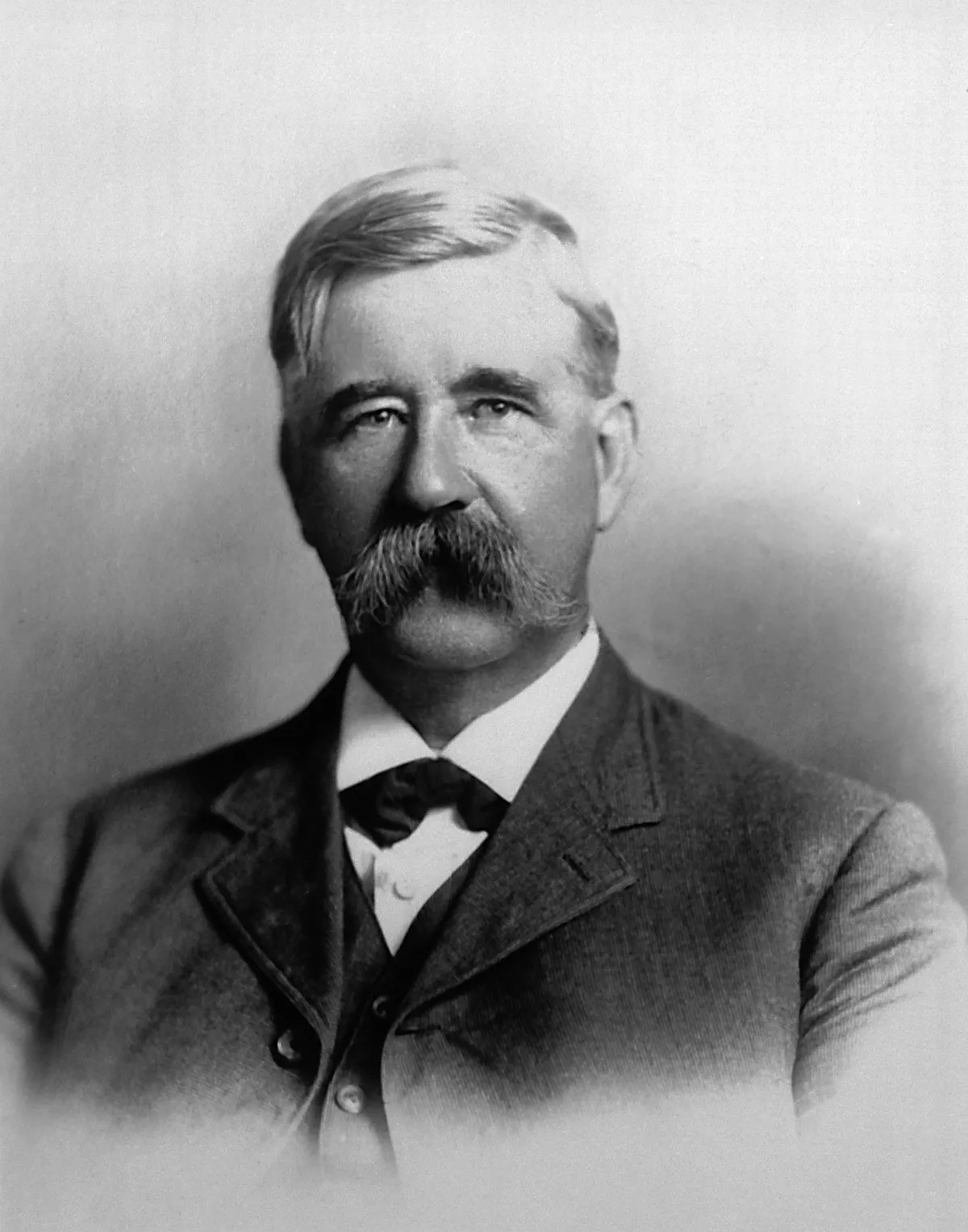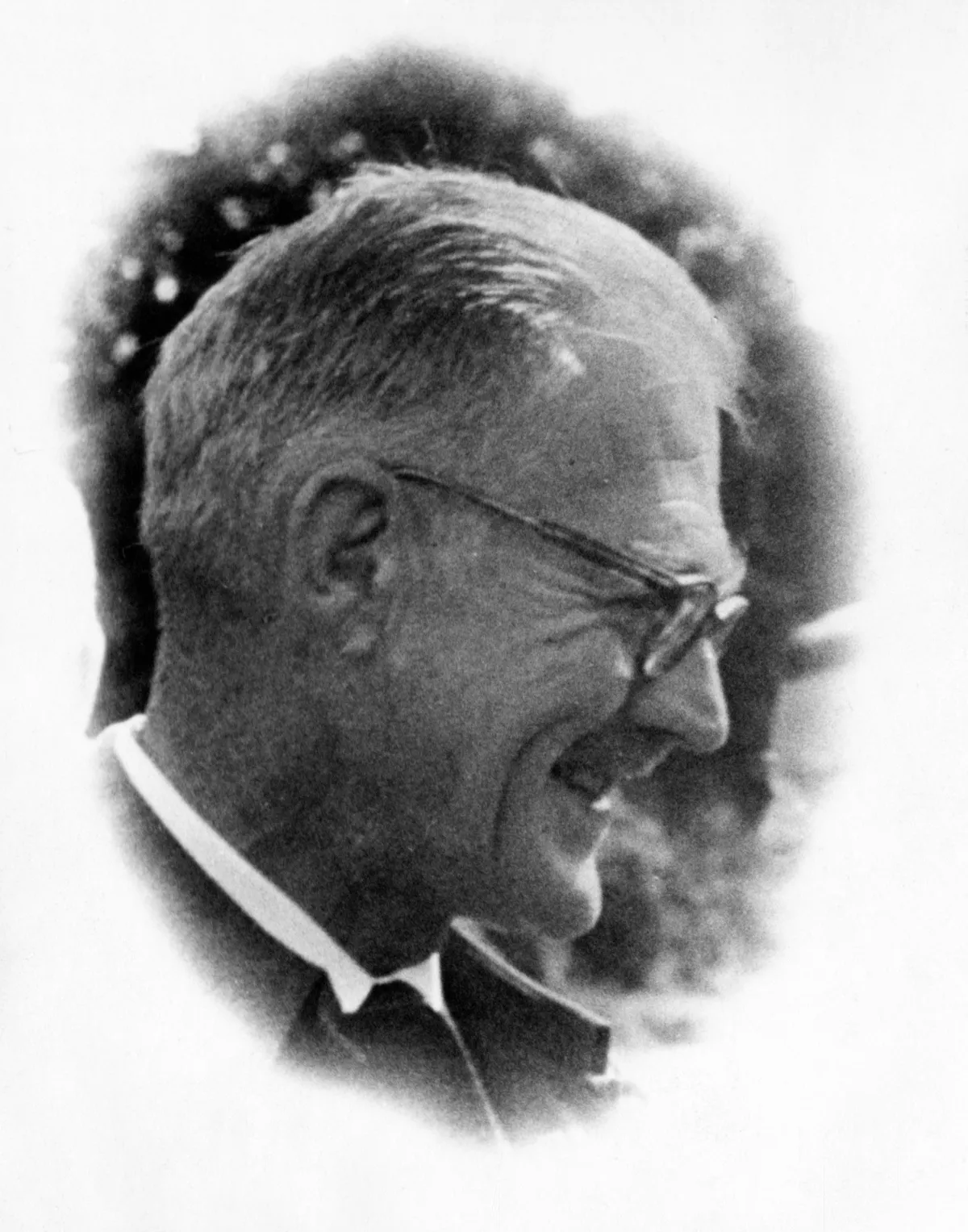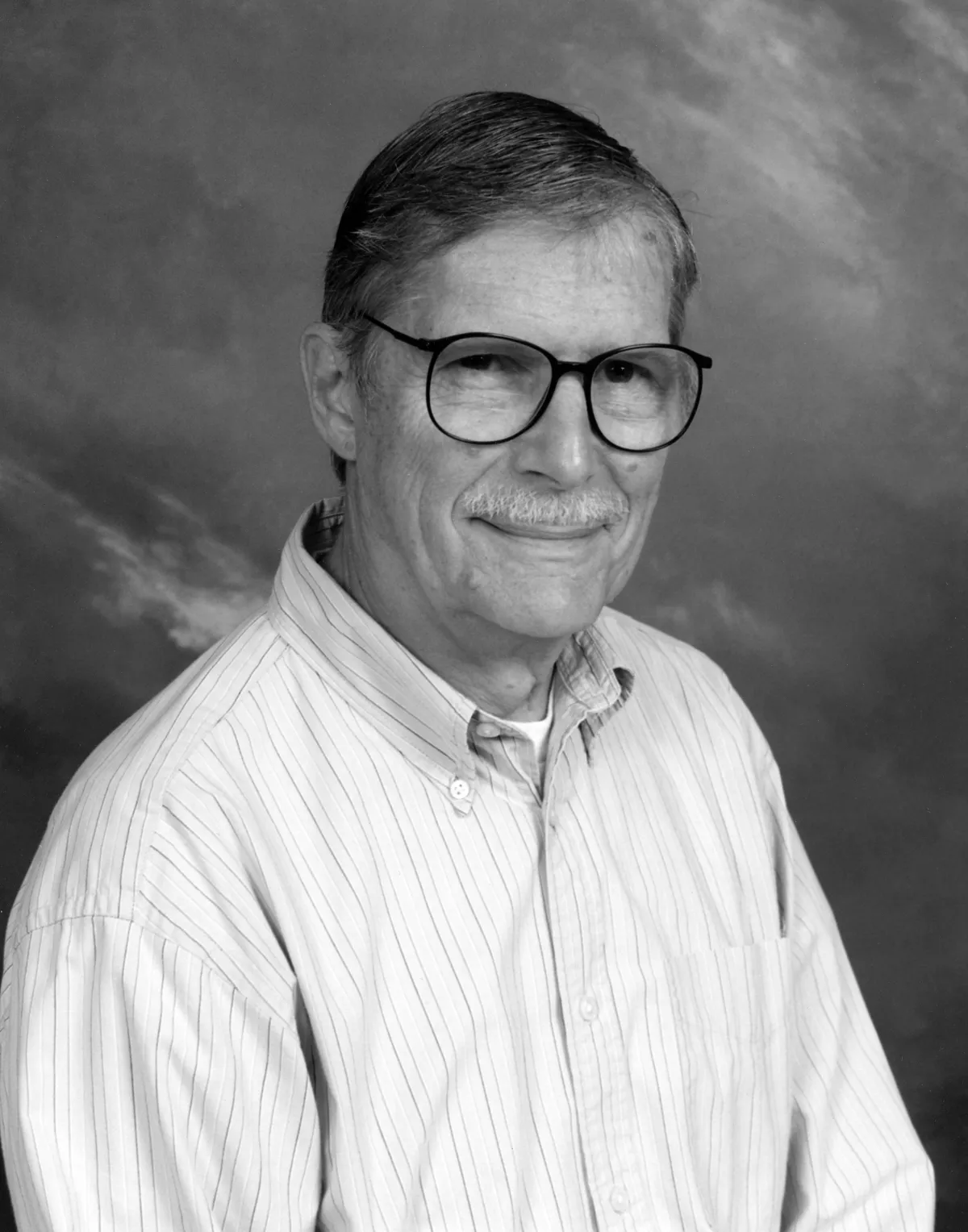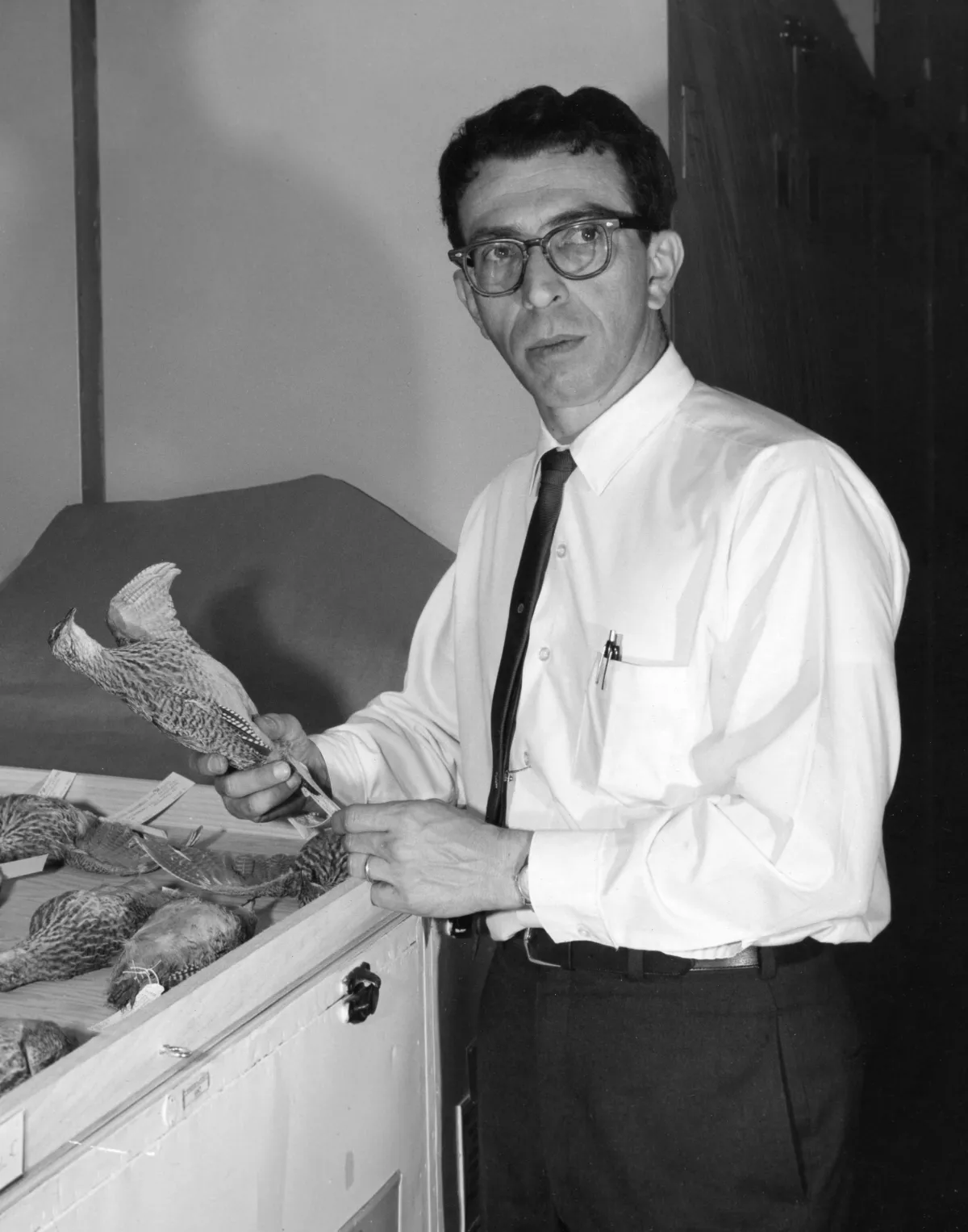
Search

History of Ornithologists at the National Museum of Natural History
History of Ornithologists at the National Museum of Natural History
This assemblage of photographs portrays some of the most influential deceased or retired ornithologists associated with the nation’s museum of natural history in Washington, D.C. Once the U.S. National Museum and now the National Museum of Natural History, Smithsonian Institution, the museum’s scientific productivity was manifestly enhanced by many ornithologists who were not Smithsonian employees but were associated with what was first the Division of Economic Ornithology and Mammalogy of U. S. Dept. of Agriculture, which was succeeded by the Bureau of the Biological Survey, then the U. S. Fish and Wildlife Service, and what is now a part of the U. S. Geological Survey.
The bird collections of the Biological Survey were transferred to the U. S. National Museum in 1889 and merged with those of the Smithsonian in 1946; responsibility for the entire collection has been shared jointly since then. Included in this gallery are three former Secretaries of the Smithsonian and three Chiefs of the Biological Survey and its predecessor. Not all the persons in this gallery held positions equivalent to the modern Curator, but those who did not were also instrumental in developing Washington as the next major focal point of American ornithology after Philadelphia. To Washington came the historically noted collections of the Exploring Expedition and the Federally sponsored railroad and boundary surveys.
Some individuals, such as Coues, were never paid staff members, but earned their place here through their contributions to, and use of, the collections for research publications. Both, like many other early American ornithologists such as Bendire and Mearns, got their start in Federal service as medical officers in U. S. Army. Emphasis at first was understandably on the North American avifauna, but the research interests of the scientific staff expanded the museum’s horizons to the West Indies, Mexico and Central and South America, Africa, eastern, southern, and south-east Asia, Oceania, Australasia, and Antarctica, whence original collections of birds were made expressly for the museum in Washington.
Descriptions of new species and subspecies flowed from the museum’s publications and elsewhere, raising the number of type specimens to many thousands. In addition to systematics and biogeography, the museum’s staff have also made substantial contributions to the anatomy and paleontology of birds as well. The collections have continued to expand not just in quantity but in quality and scope as well so that the numbers of species and individuals of birds represented as skeletons and fluid preserved specimens are unsurpassed and the skin and tissue collections are among the top five in the world. Now, Washington is one of the most important destinations in the world for museum-based studies of birds and we take this opportunity to show you some of the faces of those who made it so.

Spencer F. Baird (1823 - 1887)
Assistant Secretary of the Smithsonian Institution (1850-1878). Secretary of the Smithsonian (1878-1887). Donation of private collection of over 3,600 birds in 1850 established the Division of Birds. Instrumental in putting many researchers in the field. Founding member of American Ornithologists' Union. Member of the National Academy of Sciences.
In Memoriam <PDF>.

Elliott Coues (1842-1899)
Field collector, Army physician, naturalist on U.S. Northern Boundary Commission and U.S Geological and Geographical Survey of the Territories. Best known for publications "Key to North American Birds", "Check List of North American Birds", "Field Ornithology" and "Bibliography of North American Ornithology". Founding member of American Ornithologists' Union. Member of the National Academy of Sciences.
In Memoriam <PDF> (Wilson Bulletin)
In Memoriam <PDF> (Nat. Act. Sci.)

Robert Ridgway (1850-1929)
First Curator of Birds at the USNM (1881). Artist. Published "Color Standards and Color Nomenclature", a valuable work in many fields. Published first eight volumes of "The Birds of North and Middle America", a standard reference still in use today. Founding member of American Ornithologist Union and member of the National Academy of Sciences. Member of first AOU Committee on Classification and Nomenclature.
In Memoriam <PDF> (Auk)
In Memoriam <PDF> (Condor)

William Palmer (1856-1921)
Field naturalist and preparator. Notable collecting trips included Funk Island, Pribilof Islands, Cuba, and Java. Interested in study of molt in birds. Chief taxidermist who counted "Martha", the last Passenger Pigeon, as one of his mounts.
In Memoriam <PDF>

Leonhard Stejneger (1851-1943)
Assistant Curator of Birds (1881-1889), later Curator of Reptiles. Ornithological fieldwork included visits to the Commander Islands, Kamchatka, Puerto Rico, the Alps, the Southwestern US, the South Dakota Badlands, and Japan. Member of the National Academy of Sciences.
In Memoriam <PDF> (Auk)
In Memoriam <PDF> (Nat. Acad. Sci.)
In Memoriam <PDF> (Sys. Zoology)

Pierre L. Jouy (1856-1894)
Field collector, primarily in Japan, Korea, and China. Contributed extensively to zoological and ethnological collections at Smithsonian. Meticulous preparator of museum specimens and field notes.
In Memoriam <PDF>

Frederick A. Lucas (1852-1929)
Curator of Comparative Anatomy at USNM (1893). Published extensively on the osteology and anatomy of birds. Collected and studied bones of the Great Auk.
In Memoriam <PDF>

Charles E. Bendire (1836-1897)
Army officer. Collected eggs extensively throughout military career. Private collection of 8,000 eggs formed the basis of the egg collection at USNM. Honorary Curator in the Department of Oology under Spencer F. Baird. Prepared two volumes of "Life Histories of North American Birds." Founding member of the American Ornithologists' Union.
In Memoriam <PDF>

Edgar A. Mearns (1856-1916)
Honorary Associate in Zoology at USNM. Field naturalist, collector . Participated in numerous collecting expeditions including the United States-Mexican International Boundary Survey, Philippine Islands Expedition, Smithsonian-Roosevelt African Expedition, and the Childs Frick Expedition. Founding member of the American Ornithologists' Union.
In Memoriam <PDF>

C. Hart Merriam (1855-1942)
First Chief of the Division of Economic Ornithology and Mammalogy of US Dept. of Agriculture, forerunner of Biological Survey. Extensive collecting in the southwestern United States led him to develop the Life Zone concept. Founding member of the American Ornithologists' Union. Member of the National Academy of Sciences.
In Memoriam <PDF>

Albert K. Fisher (1856-1948)
Played a role in the creation of Biological Survey (1905). Expeditions included the Death Valley Expedition, the Harriman Alaska Expedition, and the Pinchot South Seas Expedition. Spearheaded the conservation of hawks and owls with publication "The Hawks and Owls of the United States in Their Relation to Agriculture" (1893). Founding member of the American Ornithologists' Union.
In Memoriam <PDF>

Edward W. Nelson (1855-1934)
Naturalist, ethnologist and conservationist. Chief of Biological Survey (1916-1927). Collected in the Arctic for the Natural History Museum. Later collected for the Biological Survey in Death Valley and Mexico. Instrumental in the negotiation of the Migratory Bird Treaty with Great Britain.
In Memoriam <PDF>

Theodore S. Palmer (1868-1955)
Field agent with the Biological Survey. Leader on Death Valley Expedition (1891) Specialize in the field of legislation affecting wildlife. Influential publications led to the enactment of the Lacey Act of 1900. Long time secretary of the American Ornithologists' Union. Wrote many obituaries of AOU members and fellows.
In Memoriam <PDF>

Edward A. Goldman (1873-1946)
Affiliated with the Biological Survey for close to fifty-five years. Collected extensively with Edward Nelson in Mexico. Published "Biological Expedition in Mexico" which detailed the Nelson and Goldman collecting activities. Numerous publications in both ornithology and mammalogy.
In Memoriam <PDF>

Charles W. Richmond (1868-1932)
Assistant Curator of Birds (1895). Best known for compiling "The Richmond Index to the Genera and Species of Birds" a monumental resource for establishing the nomenclature of birds. His outstanding collection of taxonomic books became the basis of the Bird Library. Member of the AOU Committee on Classification and Nomenclature of North American Birds.
In Memoriam <PDF>

Harry C. Oberholser (1870-1963)
Ornithologist for the Biological Survey. Specialized in morphology. Collected extensively in Texas and the two-volume work entitled "The Bird Life of Texas" was published eleven years after death.
In Memoriam <PDF>

Joseph H. Riley (1873-1941)
Associate Curator in Birds (1932-1941). Collected in Cuba, Bahamas, Virginia and western Canada. Assumed much of the routine care of the bird collection during his 45 yrs on staff.
In Memoriam <PDF>

Henry W. Henshaw (1850-1930)
Chief of Biological Survey (1910-1916). Collector for Wheeler Expedition (1872). Member of the AOU Committee on Classification and Nomenclature of North American Birds. While Chief of Biological Survey, Congress passed the Migratory Bird Treaty Act
In Memoriam <PDF>

Alexander Wetmore (1886-1978)
Assistant Secretary of the Smithsonian Institution (1924-1945). Secretary of the Smithsonian (1945-1952). Expert in the fields of migration, classification, distribution, avian paleontology and Panama. Member of the AOU Committee on Classification and Nomenclature of North American Birds.
In Memoriam <PDF>

Frederick C. Lincoln (1892-1960)
Chief of the Section of Distribution and Migration of Birds (1920-1946). Created, organized and in charge of Biological Survey's Bird Banding Program in North America. Leader in study of distribution and migration of birds
In Memoriam <PDF>

Arthur Cleveland Bent (1866-1954)
Contributed 30,000-unit egg collection to USNM. Continued the work started by Major Charles Bendire and wrote 19 volumes of "Life Histories of North American Birds".
In Memoriam <PDF>

Herbert Friedmann (1900-1987)
Extensively researched cowbirds and other parasitic birds. Produced a two-volume USNM Bulletin on birds of Ethiopia and Kenya. Curator of Birds (1929-1959) and Head Curator of Zoology (1959-1961). Member of the National Academy of Sciences.
In Memoriam <PDF>
NMNH Centennial site with audio clips

Herbert G. Deignan (1906-1968)
Curator of Birds (1959-1962). Specialized in the avifauna of Thailand and adjacent areas. Collected a significant assemblage of birds of Thailand for USNM. Best known for publications "The birds of northern Thailand (1945), "Checklist of the birds of Thailand" (1963) and "Type specimens of birds in the United States National Museum" (1961)
In Memoriam <PDF>

John W. Aldrich (1906-1995)
Ornithologist for the Fish and Wildlife Service. Research focused on bird-population studies and systematics. Investigated feather and bone identifications in connection with law violations. Chief of the Section of Distribution and Migration of Birds, National Bird Banding Program (1947). Along with George E. Watson III, formulated the U.S.-Japan Migratory Bird Treaty. Merged Biological Survey and USNM collections.
In Memoriam <PDF>

Roxie C. Laybourne (1910-2003)
Forensic Ornithologist (1946-88), USFWS Birds and Mammal Lab. Pioneered forensic ornithology with technique of using microscopic structures of plumulaceous feather barbules to identify bird species. Identified avian remains from thousands of aircraft-bird collisions.
In Memoriam <PDF>

Thomas D. Burleigh (1895-1973)
Forest Wildlife Biologist for Biological Survey . Chief of the Bird Section of the Bird and Mammal Laboratories in the Fish and Wildlife Service (1958-1961). Research focused on bird distribution and taxonomy. Avid collector. Best known for "Georgia Birds" (1958)
In Memoriam <PDF>

Philip S. Humphrey (1926-2009)
Curator of Birds (1961), Chair of Vertebrate Zoology (1967) Oversaw a renowned banding and collecting project in Pacific seabirds. Modernized data-recording methods for field work.
In Memoriam <PDF>

Paul Slud (1919-2006)
Associate Curator in Bird Division (1964-1983). Expert in bird vocalizations. Extensive field study led to the publication "The Birds of Costa Rica: Distribution and Ecology".
In Memoriam <PDF>

George E. Watson III (1931- )
Curator of Birds (1962-1985). Planned move of entire bird collection into east wing. Significant collecting trips included Egypt, Israel, and Antarctica. Pioneered electric data capture of bird skin collection. Along with John Aldrich formulated the U.S.-Japan Migratory Bird Treaty.

Richard L. Zusi (1930- )
Curator of Birds (1963-1994) Specialized in functional anatomy and evolution of birds. World's expert on feeding adaptations and hummingbird anatomy. Modernized the skeleton and spirit collections and initiated a world inventory of anatomical specimens.

S. Dillon Ripley (1913-2001)
Secretary of the Smithsonian (1964-1984) . Expert in Indian Birds. Helped guide and expand the world conservation movement. Best known for publications "Synopsis of the Birds of India and Pakistan (1961), "Handbook of the Birds of India and Pakistan" (1968-1974). Member of the National Academy of Sciences.
In Memoriam <PDF>

Richard C. Banks (1931- )
Chief, later Director of the bird section of Bird and Mammal Labs, Fish and Wildlife Service in NMNH (1966). Curator of Birds, Biological Survey, NMNH (1966-2005). Extensively contributed in systematics, distribution, and geographic variation of North American birds. Active in professional societies. Founded Ornithological Council. Chaired AOU committee on Classification and Nomenclature (1995-2007).

Storrs L. Olson (1944-2021 )
Resident Manager Chesapeake Bay Center at Edgewater (1968-69), Doctoral Fellowship in Birds (1971), Curator of Birds (1975-2010). Systematist and anatomist. Expert on fossil birds. Fossil discoveries of pre-human avifauna in the Hawaiian Islands led to significant contributions to systematic ornithology. Extensive fieldwork conducted around the world.
NMNH Centennial site with audio clips